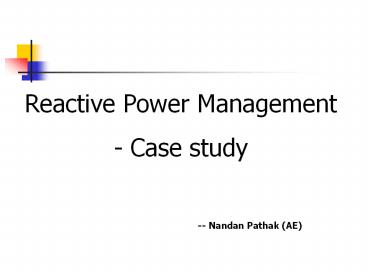Reactive Power Management PowerPoint PPT Presentation
1 / 20
Title: Reactive Power Management
1
Reactive Power Management - Case study
-- Nandan Pathak (AE)
2
Preface
3
Problem
A ) GENERATORS a) High MVAR drawl b) High
excitation current B) ICT a) Overloading due to
MVAR b) Low voltage on 220 kV bus ( 200 kV)
4
Problem
C) LOAD 11 kV side a) Overload tripping b)
Very low voltages c) Conductor snapping d)
Local load shedding 440 V side a) Failure of
transformers b) Conductor snapping
5
Analysis
- High seasonal load especially agriculture
- during October to March
- B) Failure of reactive compensation
6
Analysis
- Identification of areas
- a) Beed district
- b) Solapur district
- c) Nanded district
- d) Pabhani district
- e) Latur district
7
Analysis
- Identification of radial feeders
On similar lines loaded 11 33 feeders were
identified.
8
Action
I) Reactive power compensation available i.
Substation ----- 164 MVAR ii. Switched
capacitors on 11kV 240 MVAR (0.6 X405) II)
Focus Area 11 kV , 0.6 MVAR capacitors a.
Repairs in a central laboratory b. On site
replacement, checking, modification, training
9
Modifications adopted for optimum compensation
- 1. Cell rating 0.66 Mvar at 12 kV
- 2. De-rating at Low Voltage
- 3. Modification
- A. Fixed capacitors
- B. Addition to basic scheme
10
Modified 1.2 MVAR version
11
Modified 1.2 MVAR version
12
Action
- 4. On site demonstrations
- 5. Team visit Nasik , Pune (R ), Kolhapur,
Sangli,Parbhani
13
Observations
- 1. Reduction in overload tripping of 11 kV 33
kV feeders. - 2. Reduction in blowing of HG fuses at 33/11 kV
transformers. - 3. Reduction in conductor snapping.
- 4. Improvement in voltage profiles
- LT 105 Volts to 190 volts
- 11kV 7.6 kV to 9.8 kV
14
Changed System scenario
ICT -2
G-3
G-4
G-5
ICT -1
200 MW(160) 60 MVAR(135)
195 MW(150) 80 MVAR(140)
200 MW 60 MVAR
250 MW(200) 100MVAR(160)
250 MW (200) 100 MVAR(160)
220 kV Parli Bus
220 kV Girwali Bus
LOAD
LOAD
15
Changed System scenario
Voltage changes 220 kV 215 kV (200 kV)
132 kV 125 kV (106 kV) 33 kV 31 kV
(27 kV)
16
Changed System scenario
Radial load changes
17
KWH recorded on 11kV Matkuli feeder from 132 /
11 kV T/F at 132 kV Ashti substation
- ---Load shifted to another feeder ?--- Load of
other feeder taken on this feeder - --- kWh meter stopped due to leading PF
- Note
- 0.6 MVAR capacitor bank recommissioned at
village Pandharee on Dt.28.11.2000 - 0.6 MVAR capacitor bank added at same location
on Dt.4.12.2000 - New 0.6 MVAR capacitor bank commissioned at
Pokharni Phata on Dt.8.12.2000
18
(No Transcript)
19
Changed System scenario
Energy savings on 11 kV Matkuli feeder
20
Conclusion
1.System requires high order reactive
compensation.
2.Use of fixed value non switched/seasonal manual
switched capacitors is economical.
3. Complementary switching for optimum
compensation.
4. Dedicated setup for overall line loss
reduction.

